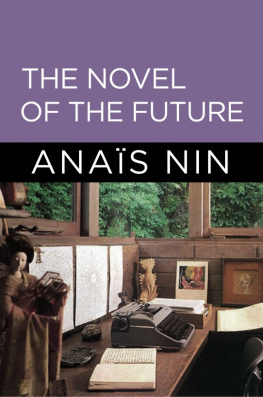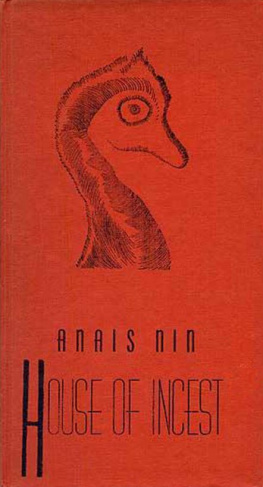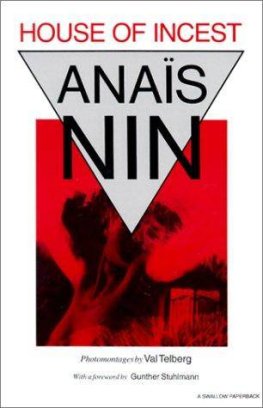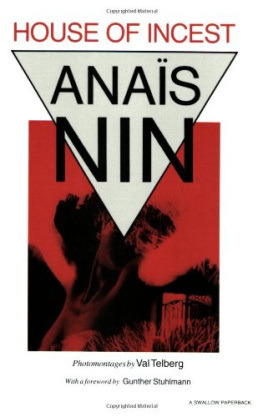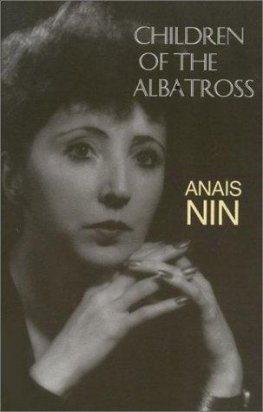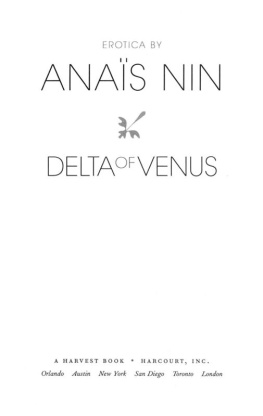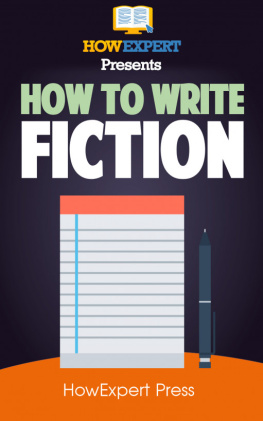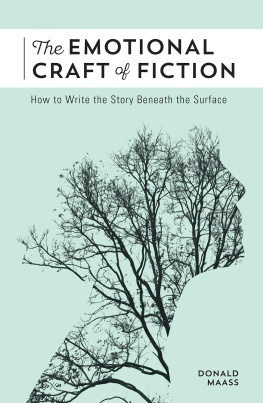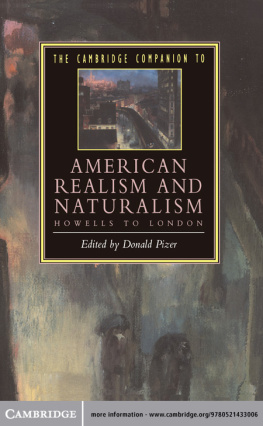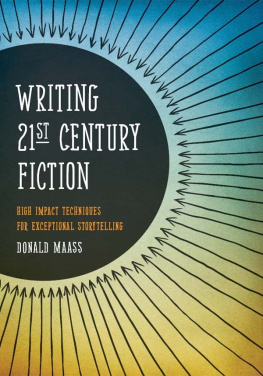THE NOVEL OF THE FUTURE
by
Anas Nin
Published by Sky Blue Pressat Smashwords
Copyright 2014 Sky BluePress
Contents 2014 The AnasNin Trust
http://www.skybluepress.com
TABLE OF CONTENTS
ACKNOWLEDGMENTS
THE AUTHOR WISHES toacknowledge the following publishers and copyright holders forpermission to quote copyrighted material:
New Directions PublishingCorporation for selections from Djuna Barnes, Nightwood , Copyright 1937 by DjunaBarnes; selections from John Hawkes, TheCannibal , and from the Introductionto The Cannibal byAlbert Gurard, Copyright 1949, 1962 by New Directions PublishingCorporation; selections from Diary ofLove , Copyright 1950 by Maude PhelpsMcVeigh Hutchins; selections from Leslie Fiedlers Introduction toJohn Hawkes, The LimeTwig , @ 1961 by John Hawkes, 1961 by NewDirections Publishing Corporation.
Dr. Margaret Meadand Redbook Magazine for selections from the January 1968 issue of Redbook Magazine .Copyright 1967 by McCall Corporation.
The Swallow Press, Inc.,Chicago, for selections from the following works of AnaisNin; Winter of Artice , Children of theAlbatross , Laddersto Fire , TheFour-Chambered Heart , A Spy in the House of Love , D. H. Lawrence: An UnprofessionalStudy , Under aGlass Bell , and Collages ; and for selections fromWallace Fowlie, The Age ofSurrealism .
Bantam Books, Inc. forselections from The Medium Is theMassage by Marshall McLuhan and QuentinFiore. Copyright 1967 by Marshall McLuhan, Quentin Fiore, andJerome Agel. By permission of Bantam Books, Inc.
McGraw-Hill Book Companyfor selections from The SuicideAcademy by Daniel Stern. Copyright 1968by Daniel Stern. Used by permission of McGraw-Hill BookCompany.
The Nation for excerpts from a review of The Diaries of Anais Nin by DanielStern in The Nation , March 3, 1968.
Houghton Mifin Company forselections from Jerzy Kosinski, ThePainted Bird .
The Viking Press, Inc., forselections from D. H. Lawrence, Twilightin Italy .
Charles Scribners Sons forselections from Marguerite Young, MissMaclntosh, My Darling .
The New York Times Companyfor selections from William Goyens article on Marguerite Youngin The New York Times , September 12, 1965. Copyright 1965 by The New York TimesCompany. Reprinted by permission of The New York Times Company,William Goyen, and Ashley Famous Agency, Inc.
For selection from The House of Breath byWilliam Goyen. Reprinted by permission of William Goyen and AshleyFamous Agency, Inc. Copyright 1950 by William Goyen.
For selection from Faces of Blood Kindred byWilliam Goyen. Reprinted by permission of William Goyen and AshleyFamous Agency, Inc. Copyright 1960 by William Goyen.
Cover photograph of AnasNins office: Karin Finell
PREFACE
LONG BEFORE SHE BECAMEFAMOUS for her Diary , Anas Nin fought a lonely battle to give America emotional,poetic fiction. During the 1940s and 1950s, her most productiveperiod, she was either ignored by the American literaryestablishment or subjected to outright hostility. But she had areputation for not caving inwhen her high school teacher told herto buy common magazines to learn common English, she left schooland taught herself how to read and write; when no one would publishher, she bought a printing press and made her own books; when shewas told by publishers, critics, friends and lovers to incorporatemore realism in her work, she not only stuck to her own methods,she wrote pamphlets and gave lectures explaining the meaning andvalue of her fiction, the culmination of which is here in The Novel of the Future .
This is a battle cry, a call to arms, arebellion against conventional fiction in which realism outweighsimagination and violence takes the place of emotion. It is asrelevant today, if not more so, as it was in 1968, when it wasfirst published. It is a blueprint for young writers who, Ninhopes, will help create a more sensitive America.
Paul Herron, Editor
This book is dedicated tosensitive Americans.
May they create a sensitiveAmerica.
Realism is a bad word. In asense everything is realistic. I see no line between the imaginaryand the real. I see much reality in the imagination.FREDRICOFILLINI from Interviews with FilmDirectors
INTRODUCTION
WHEN I FIRST began to writection I had no intention of explaining or theorizing aboutwriting. I was not involved with teaching and considered myself anindependent writer. In Paris, in the thirties, many writers aroundme were breaking the molds of the conventional novel andexperimentation was encouraged. More than that, French literatureat that time was dedicated to war against the clich, the obvious,the traditional, and the conventionalall energies were engaged ininnovation. Even those who were not dogmatic surrealists wereinuenced by its spirit. Chapters of Houseof Incest were included in the last numberof Transition . Idid not realize that with war and emigration to America would comea totally different kind of struggle. In France we felt a part of apioneering group, but in America we found ourselves isolated and inthe minority. Literature was for the masses, it was in the hands ofthe social realists, dominated by the social critics, all moreconcerned with politics than psychology or human beings inparticular. In America the aim was not to be original,individualistic, an innovator, but to please the majority, tostandardize, to submit to the major trends.
The climate of the fortieswas insular, provincial, antipoetic, and anti-European. Only a verysmall group were interested in surrealism. The majority associatedit only with Dalis pranks.
When I submitted Winter of Artice and thestories from Under a GlassBell , I was told that no one would beinterested in books dealing with life in Paris, and that the stylewas too esoteric and subjective. Today, of course, such statementssound humorous. But they were humorless in 1940. My answer was tobuy a printing press and handset and print three hundred copies ofthe two books which were sold by the Gotham Book Mart. Under a Glass Bell attracted the attention of Edmund Wilson, and because of hisreview a publisher cautiously published Ladders to Fire .
The book was received withdirect attacks on surrealism. The label stuck for years as anexpression of ostracism. Very few in America then had read thesurrealists. Andr Bretons Nadja had not yet been published in English.
But my difficulties withpublishers and critics were slight compared to my difficulties withclose friends and people whose opinion I respected. When Iwrote Stella (which was to be the beginning of a long novel, but whichturned out to be a novelette), it was my rst attempt to extend thepoem, to carry into prose the poetic condensations and abstractionsof the poem. I found myself with a group of friends who questionedthe reality of Stella because I had left out so much of the realistictrappings and concentrated only on those having a direct relationto the emotional drama: Stellas clothes, her spiral stairway, atelephone. The questions were sharp and demanded lucid answers. Itwas at this moment that I began what seemed at rst a purelydefensive interpretation of abstraction, of deleting theunessential, the upholstery, the commonplace, and the obvious. Iwrote a pamphlet called Realism andReality .[1]
Stella was reprinted in full in HarpersBazaar . I was invited to lecture atuniversities. I found myself answering more questions and probings.I found it necessary to solidify my attitude, to formulate atheory. The theory was not an innovation in terms of Frenchliterature, but it was to an America which was almost completelyAnglo-Saxon in matters of writing in spite of its many expatriates(Annette Baxter wrote an interesting study on the fact that afterten years in France Henry Miller remained a thoroughly AmericanWriter). Surrealism was an unpopular term in the 1940s. Evenrecently it was confused by academic critics with baroque horrorstories.
Next page
